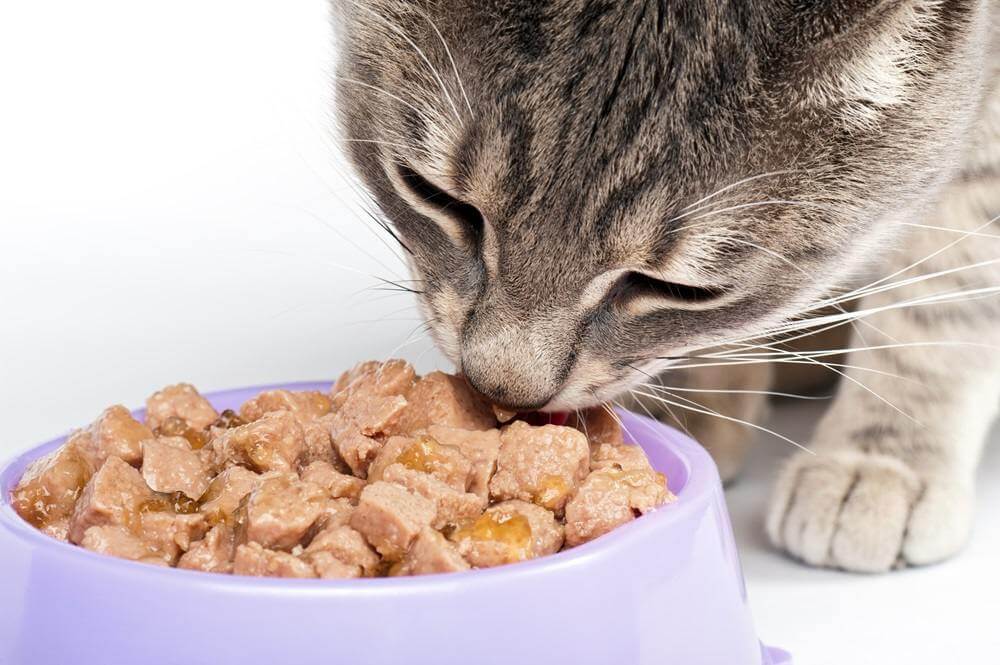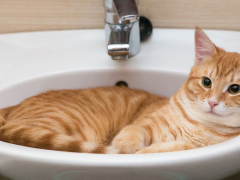
Roman Samsonov / Shutterstock.com
You’d never feed your cat something dangerous. But do you know what everything on your cat food label means? One word that stumps many pet owners is ash.
In this guide, we’ll discuss what ash in cat food really is and explore the common misconceptions surrounding it. Let’s start with an overview of ash and its role in a balanced feline diet.
Ash in Food Labels
Cat food labels provide plenty of answers—and some confusion. You’ll need to look a little further than the ingredients list to determine the nutritional value and whether it’s a good choice for your cat.
That’s where the Guaranteed Analysis comes in. It’s the table that lists crude protein, fat, and fiber levels—along with the product’s moisture content. The Association of Feed Control Officials (AAFCO) requires cat food labels to list these values.
Pet food manufacturers have the option to list additional nutrients, such as omega-3 fatty acids and essential vitamins. Some manufacturers also include ash in the Guaranteed Analysis. But why would they add such a strange ingredient? In the context of pet food, the term ash refers to the mineral content of the product.
Here’s how Dr. Jo Myers, DVM, a veterinarian at Vetster, explains it, “The pet food industry uses ‘ash’ to describe calcium, phosphorus, iron, and other minerals present in the food. It gets its name from the process: samples are burned until only non-combustible elements remain.”
So ash isn’t an additive or filler—it just refers to the mineral content in pet food.
The Role of Ash in a Feline Diet
An ideal diet for carnivores consists primarily of animal ingredients (meat, poultry, eggs, and fish) with minimal carbohydrates. In the wild, cats get everything they need from the tissues, organs, bones, and stomach contents of their prey.
If you were to burn the whole carcass of a mouse, for example, you’d be left with ash. The same kind of ash is left behind when commercial cat food products are burned. That said, the mineral makeup of ash differs depending on the product. Higher ash content equates to higher mineral levels.
Dr. Neus Torrent, DVM, a veterinarian and animal nutritionist for Outdoor Bengal, says, “Minerals are essential to cats; however, high ash levels in cat food can negatively influence the digestibility and absorption of other nutrients like protein, vitamins, and trace elements.”
Finding the right balance of minerals is key. Too much phosphorus in your cat’s diet could interfere with the absorption of calcium and increase your cat’s risk for kidney disease. Too much dietary calcium could negatively impact healthy bone formation.
To put it simply, ash is vital, but too much could be detrimental.
Crude ash content of around 2% on a dry matter basis is generally sufficient to meet a cat’s mineral requirements. Higher levels of ash alone aren’t necessarily an indicator of a poor-quality cat food product, but excessive ash content often has the same effect as a filler ingredient in cheap cat food—it takes up space without benefiting your cat.
Ash Content in Common Food Types

The ash content tends to be lower in wet cat foods. Chengdongshan / Shutterstock.com
The ash content of commercial cat food products varies greatly depending on the food type and the ingredients. Dry cat food tends to be higher in ash than wet cat food. When ash content isn’t listed on a pet food label, the ingredients themselves can provide some clues.
A product that features chicken meat might be lower in ash than one that features chicken meal. Because chicken meal is sometimes derived from whole chicken carcasses, it may contain skin and mineral-rich bone as well as muscle meat. Animal by-products and by-product meals are also likely to increase the ash content of a product because they may include necks, feet, and other bones. White meat and fish tend to have lower ash content than dark meats like lamb and beef.
And don’t forget to consider added nutrient supplements. Synthetic minerals like calcium carbonate, potassium iodide, or sodium selenite contribute to the product’s ash content.
Some evidence suggests chelated minerals—mineral molecules bound to protein molecules—are more easily absorbed by the body. The more absorbable something is, the less of it is required. So cat foods that contain chelated minerals like zinc proteinate or copper chelate may be lower in ash than products that rely on non-chelated minerals.
Dr. Torrent brings up another important factor in determining the ash content of a cat food product: moisture level. When making a direct comparison between two products, you need to convert the nutrient values to dry matter. “All wet food is going to have an ash level lower than dry foods,” Dr. Torrent says, “so compare ash content between products of the same category.”
Debunking the Myths About Ash in Cat Food
The pet food industry causes consumer confusion by leaving a lot up to interpretation. Let’s clear up some common misconceptions about ash in cat food with these four truths:
1. Ash Doesn’t Indicate Burnt Ingredients
Burning food is the only way to determine its total ash content, but that’s just part of the research process used to create the food label data. Burnt ash isn’t actually used as an ingredient. The minerals in cat food come from the ingredients themselves, which may include meat, bone, vegetable matter, and mineral supplements.
2. Ash Won’t Cause Urinary Problems
In the 1970s and 80s, researchers discovered a link between high mineral content in cat food and urinary crystals. They concluded that high-ash cat food increased the risk for urinary tract problems like struvite crystals. But we’ve since discovered it is more complicated than that.
When the cat’s urine pH becomes very alkaline, struvite crystals are formed from magnesium, phosphorus, and ammonium. Numerous health conditions can affect urinary pH, as can the protein content of a cat’s diet. Cats tend to have naturally acidic urine due to the high protein content of most cat foods.
High-ash cat food isn’t the only factor responsible for urinary issues, it may contain excessive levels of the specific minerals that lead to crystal formation. Dr. Sabrina Kong, DVM, a staff veterinarian writer at WeLoveDoodles, says, “A balanced ash content is crucial, especially for male cats prone to urinary blockages.”
3. Ash Won’t Cause Kidney Disease
The link between kidney disease and ash content in cat food is complex. Kidney disease has the potential to make your cat’s urine more alkaline, as can a restricted protein diet, which is often prescribed for kidney disease in cats. However, high mineral levels in cat food won’t independently cause kidney disease.
Dietary management for kidney disease involves controlling levels of specific minerals and protein, so low-ash cat food isn’t a guaranteed solution. For example, restricted phosphorus intake has been shown to improve prognosis for cats with kidney disease. But feeding your cat low-ash cat food could contribute to deficiencies in other key minerals.
4. Not All Raw Cat Food Is Low in Ash
All raw cat food diets are not created equal. A homemade diet that consists primarily of raw muscle meat might be low in ash, but one made with whole animal carcasses might not be. The ash content of raw cat food varies greatly depending on the ingredients. Raw foods with significant amounts of bone, ground eggshells, or mineral supplements tend to be particularly high in calcium and phosphorus.
Choosing the Right Cat Food

Ash content alone is not enough to judge the quality of a diet. Viktor Lugovskoy / Shutterstock.com
Many pet food manufacturers decline to include ash in the Guaranteed Analysis for their products and the reasoning is simple: consumers are likely to misinterpret it.
“Pet food packaging is crafted to entice buyers,” says Dr. Myers, “and much of the label content is neither legally mandated nor informative.” Whether high or low, ash content may confuse the average cat owner. “Assertions about low ash content are sometimes portrayed as indicators of high-quality cat food,” says Dr. Myers, “but this is inaccurate.”
Ash content may not determine a product’s quality, but it may be important for cats with certain health conditions. If your cat has a condition impacted by specific minerals, your veterinarian will advise you on dietary management strategies.
Frequently Asked Questions
What is another name for ash in cat food?
Ash is sometimes listed as “crude ash” when included in a cat food’s Guaranteed Analysis but may also appear as “inorganic matter” or “incinerated residue.” The term simply refers to the mineral content of the product, determined by heating the food to 550 to 600 degrees Fahrenheit and then measuring the residue.
Is ash good or bad for cats?
Ash isn’t an added ingredient—it just refers to the total mineral content of a cat food product. This being the case, a nutritionally complete diet for cats necessarily includes some ash.
How much ash is okay in cat food?
In the wild, cats would obtain essential minerals from raw bone or plant matter in the stomach contents of their prey. In commercial cat food, ash typically comes from a combination of bone, plant ingredients, and added supplements. Crude ash content up to 2% on a dry matter basis is considered ideal for most healthy cats.
-
Labeling & Labeling Requirements - AAFCO. (2023, January 28). AAFCO.
-
What’s in the ingredients list? - AAFCO. (2023, January 27). AAFCO.
-
Dacvim, C. R. H. V. M., & Dacvim, C. R. H. V. M. (2022, March 16). To chelate or not to chelate [Minerals]? Clinical Nutrition Service at Cummings School.
-
Schauf, S., Coltherd, J. C., Atwal, J., Gilham, M., Carvell-Miller, L., Renfrew, H., Elliott, J., Elliott, D. A., Bijsmans, E., Biourge, V., Watson, P., & Bakke, A. M. (2021). Clinical progression of cats with early‐stage chronic kidney disease fed diets with varying protein and phosphorus contents and calcium to phosphorus ratios. Journal of Veterinary Internal Medicine, 35(6), 2797–2811.







